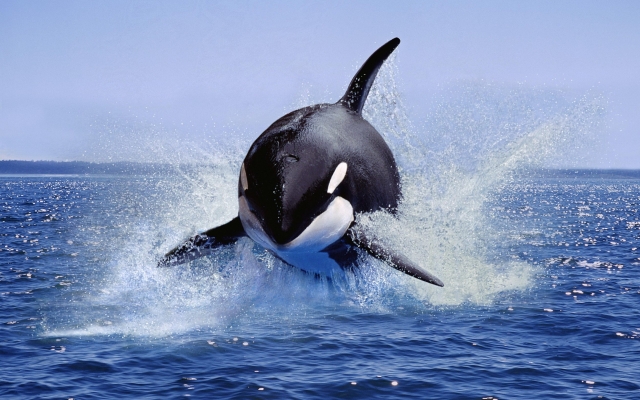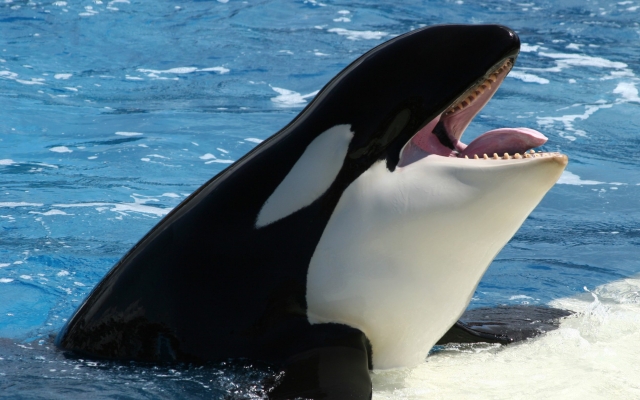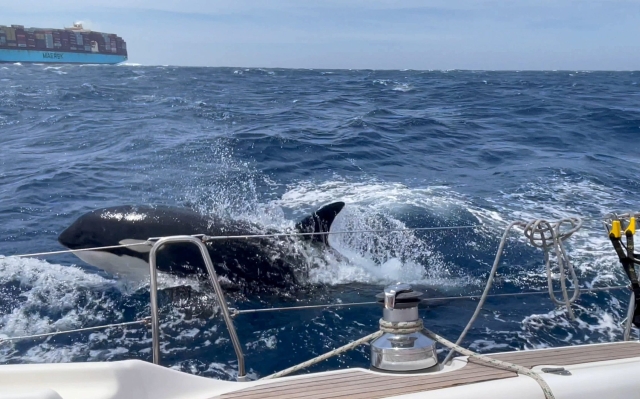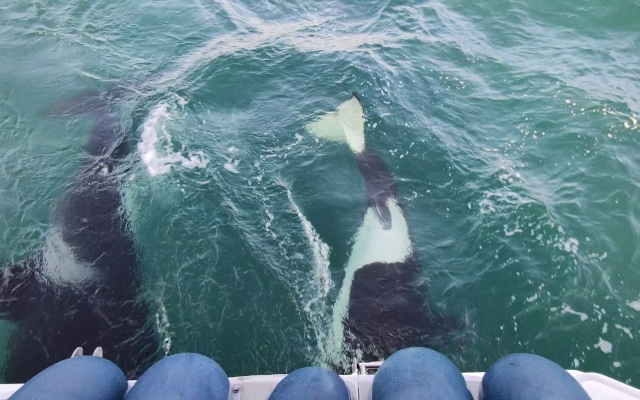 Some believe that a female killer whale named «White Gladys» suffered a collision with a boat or became entangled in a fishing net, leaving her mentally disorder. Credit: Getty Images/iStockphoto
Some believe that a female killer whale named «White Gladys» suffered a collision with a boat or became entangled in a fishing net, leaving her mentally disorder. Credit: Getty Images/iStockphoto
Alfredo López, a marine biologist at the University of Aveiro and the Atlantic Orca Task Force, believes a female killer whale named «White Gladys» was hit by a boat off the coast of Spain or got stuck while fishing. net — leaving her traumatized.
According to Lopez, the encounter «flicked a behavioral switch», triggering aggressive behavior that has since been passed on to other members of the pack.
It emerged last week that the behavior had spread further north after Dr. Wim Rutten, a 72-year-old retired Dutch physicist and experienced yachtsman, said a killer whale repeatedly rammed his boat off the coast of Shetland, creating «soft bumps» on the hull .
Others are not convinced. First, no humans were harmed in any of the killer whale attacks, although the creatures are more than capable of destroying boats and killing sailors.
Who can forget the BBC Earth episode showing a capsule of killer whales working together to create a wave to knock a seal off an iceberg into the water, where it was quickly eaten?
Copy of killer whale quote
Orcas are not actually whales , they belong to the dolphin family, and their name is short for «whale killer». They have been known to prey on whales many times their size.
Thus, the number of missing human bodies suggests that there is no sinister motive behind the contact. It is important to note that there was no record of any contact with people swimming from boats.
And the «injured killer whale» scenario only works if we perceive killer whales from a human perspective, projecting a human psychology on animal behavior. .
Robin Muat, assistant manager of the VisitScotland iCentre in Lerwick, said: “It sounds like a conspiracy theory. There is no offended killer whale that has become a bit of Moby Dick.
“They are playful, interested in what is going on, but they never touch people. Mostly they just watch, and if what happened happened, I'm sure it would be accidental.
«They are also smart creatures, so maybe they realized that if they push the propeller , they can stop that floating thing or move in a new direction. But they don't chase annoying people.»
 A killer whale with its mouth wide open is ready to catch some fish. Bergen and Lerwick, who left Norway the same week as Rutten, said they saw no killer whales on the crossing, and the UK Coast Guard Agency said no incidents were reported.
A killer whale with its mouth wide open is ready to catch some fish. Bergen and Lerwick, who left Norway the same week as Rutten, said they saw no killer whales on the crossing, and the UK Coast Guard Agency said no incidents were reported.
Fridtjof Bergmann, chairman of Shetland Race , said: “There was no confrontation or damage. One year we had killer whales on the starting line, which was impressive, but they weren't a problem. There is nothing to scare people.”
Credibility bias is nothing new
Italians Ambrogio Fogar and Mauro Mancini were sailing the Rio de la Plata between Argentina and Uruguay when a pod of killer whales attacked their yacht Surprise. sink a ship in just four minutes.
The couple, on their way to circumnavigate Antarctica, were left clinging to a raft for 74 days. The journalist Mancini eventually died while awaiting rescue. This story may sound like recent reports of killer whale attacks, but it happened in 1978, proving that clashes between sailors and killer whales have been going on for at least decades.
Undoubtedly, cases of killer whale attacks on boats have become more frequent recently. last years. In the days of Fogar and Mancini, the logbook was the only way to record a life-threatening collision at sea.
In fact, their story made it into the international press only because Fogar was a famous adventurer and the survival story was extraordinary. The couple clung to the raft for more than two months, feeding on rainwater, shellfish and cormorants, which they oared to death.
Today, even the most banal encounter can be circulated on social media within minutes, giving issues more weight than they deserve because they are captured by establishment bias — a distortion in measuring the true frequency of a phenomenon due to the way the data is collected.
“The Covid Effect”
The pandemic has also brought a surge in sailors. Boat sales are up 30% in the first quarter of 2020, as are puppies and sourdough, according to the National Marine Manufacturers Association. And the more boats, the more chances of encounters.
Most attacks occur near popular killer whale sightings, such as the Portuguese port of Sines, where killer whales sank a boat of five people last August.
Some tour boats toss in mackerel and herring to lure killer whales for photography, while fishing boats often send by-catch and fish intestines, making killer whales associate boats with food.
 Killer whale attacks sailboat during hour-long attack Photo: Stephen Bidwell/SWNS
Killer whale attacks sailboat during hour-long attack Photo: Stephen Bidwell/SWNS
Wilderness expert Hugh Harrup of Shetland Wildlife said the attack in Shetland was likely provoked by Mr Rutten, who was fishing. mackerel from the back of his boat.
«There is a clear link between killer whales, herring and mackerel, so we shouldn't be surprised when a killer whale approaches a smaller boat,» he told The Shetland Times.
Lopez told The Daily Telegraph that he believes in COVID-19. could be one of the factors.
“If the increase in the number of boats implies an increase in tuna poaching, then yes. This behavior is associated with fishing for tuna from sailboats,” he said.
During quarantine, dolphins were recorded bringing gifts of coral and glass bottles to Barnacles Cafe and the Dolphin Feeding Center in Queensland, Australia, which indicates that they lack ordinary human communication.
Anna Bunny, head of education at the marine conservation charity ORCA, said it was impossible to say for sure if Covid could be related, but acknowledged that recent recorded sightings of killer whales began in mid-2020.
Quote from killer whales
“It is difficult to blame Covid as the cause of these interactions, perhaps they are a thing of the past and have not been reported,” she said. “There has definitely been an uptick in recent months, but it is likely that as more reports reach the media, there will be broader public interest and just more attention to the attacks.”
Lissa Baty, Head of Marine Conservancy at the Wildlife Trust, said: “I was wondering if there could be an increase in boat traffic and capacity in Gibraltar.
“When there were several boats, maybe the killer whales were less fussy, there was enough space for everyone. Maybe there are too many boats now and killer whales are defending their territory. More boats, more interactions. Or perhaps the man sensed he was being disturbed by a yacht and pounced to protect himself.”
Orca whims
If ramming boats and chewing rudders seems like an unusual pastime, it's nothing compared to a dead salmon hat. 1987 trend.
In the late 1980s, conservationists in the Puget Sound region of the Pacific Northeast noticed that a female killer whale began wearing dead salmon on her nose, and this quirk quickly spread to two other flocks. The whales carried the fish on their heads for six weeks.
 Two killer whales attack a yacht off the Iberian Peninsula in 2021. Credit: BNPS
Two killer whales attack a yacht off the Iberian Peninsula in 2021. Credit: BNPS
He was seen again the following summer several times before disappearing completely.
Killer whales are highly intelligent and also quite bizarre, exhibiting strange behavior for several months before moving on. Some killer whales have been seen clinging to the dorsal fins of larger males to catch a ride, and in 2005 a killer whale in Marineland learned to catch gulls using regurgitated fish as bait, a trend that has been passed on to other species. /p>
Recently, killer whales in British Columbia have attacked crab traps by raising and moving their anchors for no reason, and killer whales in the Salish Sea near Vancouver will harass porpoises.
Renaud de Stefanis, head of the Spanish cetacean observatory CIRCE, believes that young killer whales may have taken a liking to the churned foamy water churned by propellers.
Some have been seen enjoying the high-pressure wake from the propellers. and Stefanis suggested that they might ram the rudder of the sailing ships to encourage the crew to turn on their engines.
Copy of a copy of a copy of a quote from killer whales
«We think it's just a game for them,» said Stefanis, who was tasked with write a report on why killer whales attack. He doesn't think they have malicious intent.
“If two or three killer whales really attacked the yacht, they would sink it in a matter of seconds,” he added.
Some sailors believe that killer whales are intrigued by the rudders. Nick Withers, a member of the Orca Attack Reports Facebook group, said: «Where else in the ocean is there structure and rudder movement?»
What's next?
Do killer whales really hold a grudge? against people or just for play, attacks are a headache for the travel industry.
Foreign sailors are now avoiding Portuguese waters and heading straight for Madeira and the Canary Islands. Those who remain resort to guns or firecrackers to scare off killer whales, a strategy that could heighten tensions and possibly eventually lead to loss of life.
Portuguese Navy, Institute for Conservation of Nature and Forests and ANC are trying to find a solution to the incidents and are currently considering the installation of an underwater acoustic device on popular swimming routes.
As with salmon hats, the trend of boat attacks may soon disappear. What is clear is that killer whales are not going to catch people and leave as soon as the boats stop. Nearly all of the attacks were committed by minors, indicating noisy teenage pranks rather than actual intent to cause harm.
As David Neivert, author of Killer Whales and Humans: What Killer Whales Can Teach Us, said recently. it's: «It's just killer whales that remain killer whales.»
At this point, it's probably still safe to enter the water.


























































Свежие комментарии